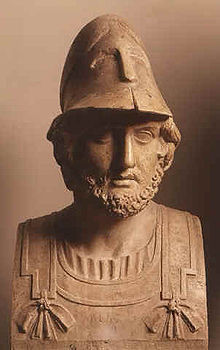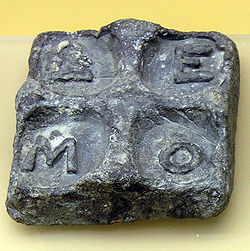AGMSPRITE Analysis
MilitaryThemistocles was an Athenian politician and a general. He was a different type of politician; who rose to prominence in the early years of the Athenian democracy. Themistocles was a populist, he was elected archon in 493 B.C. He had the support from the lower class of Athenians and had to go against the Athenian nobility. What he was known for were the steps to increase the naval power of Athens, which would be a recurring theme in his political career. During the first Persian invasion of Greece, he fought at the Battle of Marathon, and he became prominent politician in Athens. He sought out for a strong Athenian navy, and in 483 BC. He also had the Athenians build a fleet of 200 triremes; this would assist in the forthcoming war with Persia. Themistocles was an effective commander in the battles of Artemisium and Salamis.After the conflict ended, Themistocles continued to be within the Athenian politics.
In 472 or 471, Themistocles life turned into a downward spiral, since implicated the treason against the gerneral Pausanias. So he fled from Greece and traveled to Asia, where he worked for the Persian king Artaxerxes I. He was also made governor of Magnesia, and lived there for the rest of his life. What his life story suggested was that an Athenian could rise from the lower class to be a politician or even a general which was normally an elite's job. |
SocialIn Rome, the social structure was hierarchical, but there were multiple and overlapping social hierarchies. The status of the Romans was determined by ancestry, census, nobles, and citizenship. The ancestry comes to play by the Romans are born into the social status, for example the roman person could be born into a patrician or a plebian social rank. Then there is the census rank which the person is based on wealth and the political privilege with the senatorial and equestrian ranks higher than the ordinary. If your family was noble you had the attainment of honors. Citizenship is where they have the grades with different rights and privileges. Men who lived outside of Rome may have citizenship, however they lack the ability to vote. A free born woman was a citizen, but could not vote or hold political office. There was also a class of non-citizens with different legal rights, such as the slaves had no rights were considered property. The Roman society was patriarchal in the purest sense; the male was the head of the household and held powers that allowed him jurisdiction over all his family. The word patronus deriving from pater, "father", was another way of depicting the hierarchical groups, though there was a system of overlapping social networks. Also the way the Romans wore their clothing depicted what their social status was. For example the higher class tends to wear the toga which showed that you were in a higher class status.
|
PoliticalA Roman Republic was set in place instead of a normal monarchy. It is a system that is based on annually elected officials and different representatives assemblies was established. There was a system that set a series of checks and balances to ensure that the power was equally spread, it was called a constitution. It set up two politicians who shared their power to get things done especially in the command for the military. The political structure was set up so that the consuls had to work with the senate, then the advisory council of the ranking nobility, or called patricians, but it grew in size and power. The Republic includes the tribunes, quaestors, aediles, praetors and censors. The role of the magistracies were originally restricted to patricians, however it was open up to the common people.Republican voting assemblies included the politicians which voted on matters of war and peace and elected men to the most important offices. Also there was political system of Athens, it was called a Direct Democracy. Males who were born and raised in Athen's that were over the age of twenty and had two Athen parents were able to vote in the Athenian assembly. The Assembly functioned as the legislative body; making laws and taking decisions. After the Assembly there was the Counsil. The Council was for all male citizens over the age of thirty and they were entitled to put their name forward to serve on the Council. Then like the Roman political system there was the Magistracies.The post was held for only a year and, at the end of the year, he would have to report and tell the Athenian jurors how he spent his time in office and how much money he spent. This shows how they want to ensure that the power the guy held was not abused since in other civilizations the power has been abused by the kings and dictators.
|
ReligionTraditional Maya religion, is a belief system in which the habititual religious practice is in contradistinction to orthodox Roman Catholic ritual. There is the practice called Maya landscap. It is a ritual topography, with landmarks such as mountains, wells and caves being set to different ancestors and Gods. The Ritual was governed only by the geographical lay-out of shrines and temples, but also by the projection of the models on the lanscape to go with the calander.In the Northwestern Maya highlands, for four days, or called day Lords, start the year with the assigned four mountains. The main calendars governing ritual have the cycle of 260 days, important for individual rituals, and the year of eighteen months. The maize was important to the mayan civilization because it sustains the civilization. There is the forms sacrifice might take varies considerably. In contemporary sacrificial rites, there is an overall emphasis on the sprinkling of blood, especially that of turkeys. The sacrifice usually consisted of animals such as deer, dog, quail, turkey, and fish, but on exceptional occasions also came to include human beings. An ancient Mayan ritual was the "bloodletting" sessions held by high officials and members of the royal families, during which the earlobes, tongues, and foreskins were cut with razor-sharp small knives and stingray spines; the blood fell on paper strips that were possibly burnt afterwards. This shows how intense the religion was in their culture.
|
EconomyThe geographical position of Greece allowed them to engage with the rest of the world. The areas which Greece traded with wheat were Cyrenaica, Egypt, Italy, and regions surrounding the Black Sea. Of the many things Greece trades with the surrounding countries the imported products included,papyrus, spices, fabrics, metals, and shipbuilding materials such as wood, linen, and pitch, grain was also imported. Greece exported wine, pottery, and olive oil. This allowed the Greek economy to prosper and it let the population grow. The complex economy system upheld the country of Greece, without the trade Greece would have died alone because you need to interact with the other countries to share different beliefs and new technology to further the country.
|
Citations
"Ancient Rome." Wikipedia. Wikimedia Foundation, 11 Sept. 2012. Web. 09
Nov. 2012. <http://en.wikipedia.org/wiki/Ancient_Rome>.
"Describe the Political System of Ancient Athens?" WikiAnswers.
Answers, n.d. Web. 09 Nov. 2012.
<http://wiki.answers.com/Q/Describe_the_political_system_of_ancient_Athens>.
"Maya Religion." Wikipedia. Wikimedia Foundation, 29 Oct. 2012. Web. 09
Nov. 2012. <http://en.wikipedia.org/wiki/Maya_religion>.
"Economy of Ancient Greece." Wikipedia. Wikimedia Foundation, 11 July
2012. Web. 09 Nov. 2012.
<http://en.wikipedia.org/wiki/Economy_of_ancient_Greece>.
Nov. 2012. <http://en.wikipedia.org/wiki/Ancient_Rome>.
"Describe the Political System of Ancient Athens?" WikiAnswers.
Answers, n.d. Web. 09 Nov. 2012.
<http://wiki.answers.com/Q/Describe_the_political_system_of_ancient_Athens>.
"Maya Religion." Wikipedia. Wikimedia Foundation, 29 Oct. 2012. Web. 09
Nov. 2012. <http://en.wikipedia.org/wiki/Maya_religion>.
"Economy of Ancient Greece." Wikipedia. Wikimedia Foundation, 11 July
2012. Web. 09 Nov. 2012.
<http://en.wikipedia.org/wiki/Economy_of_ancient_Greece>.





